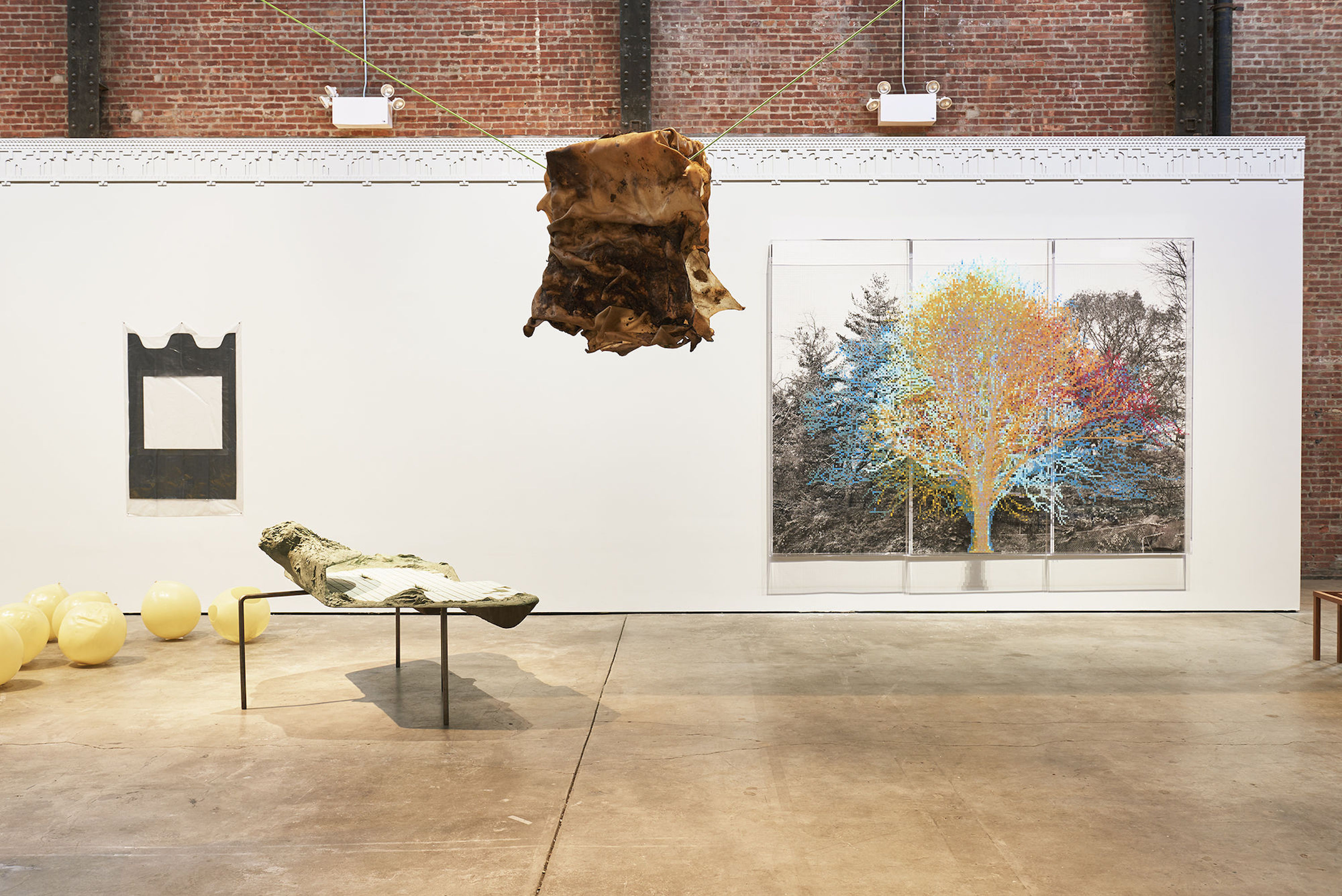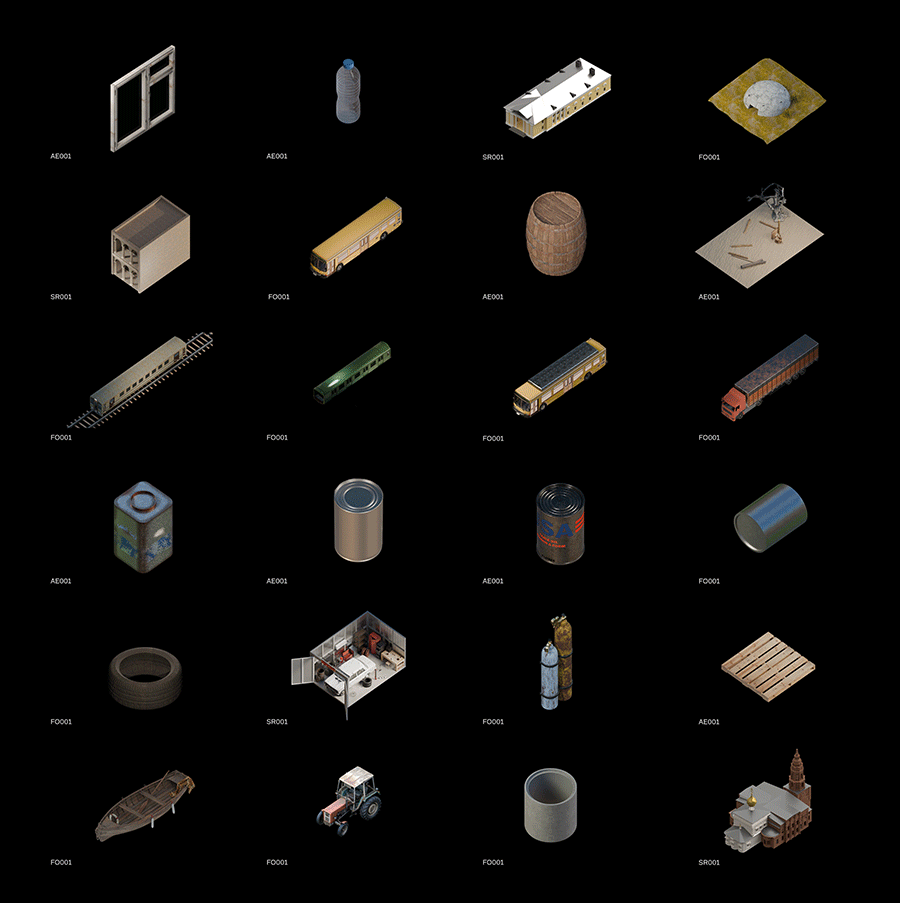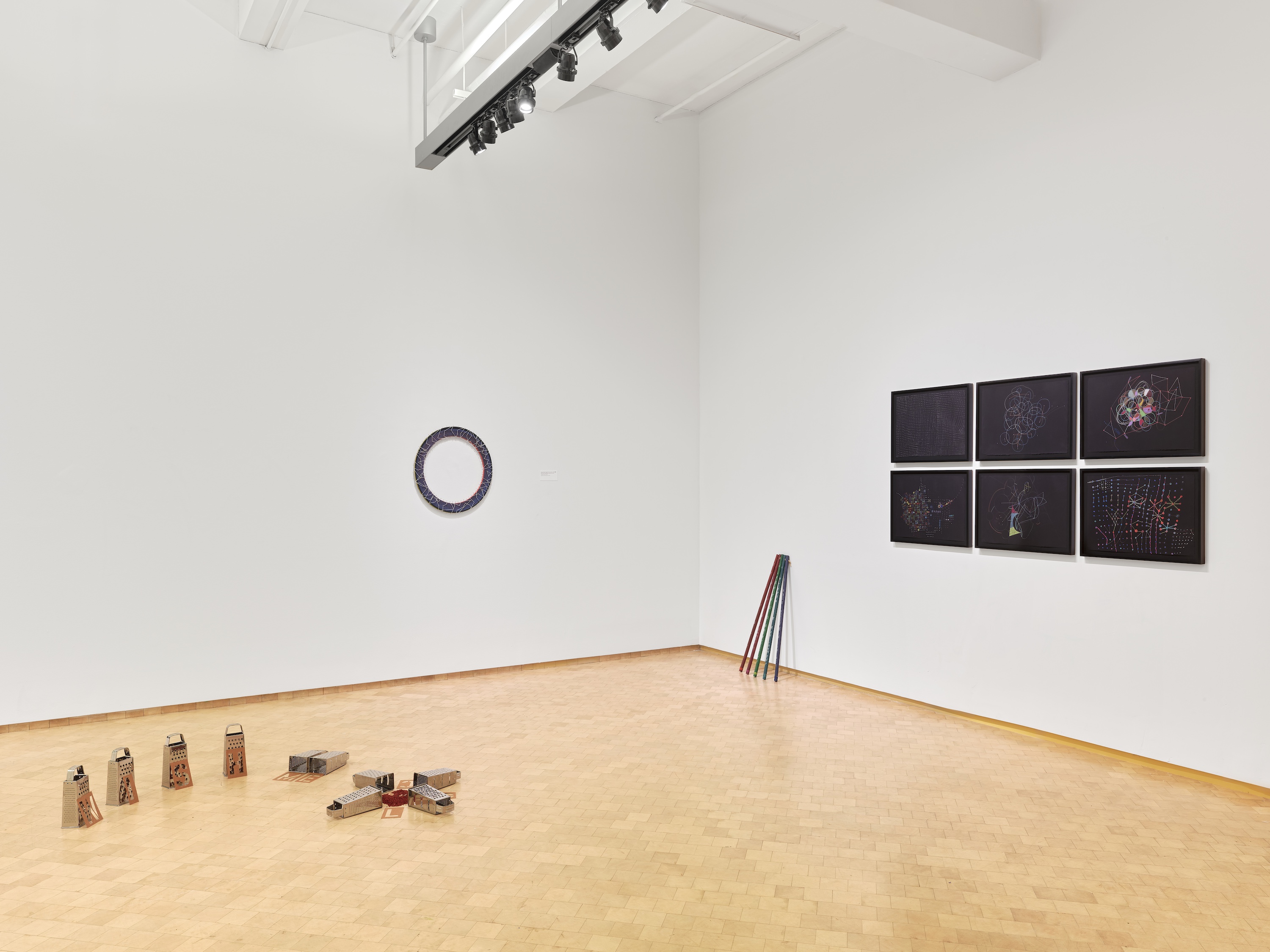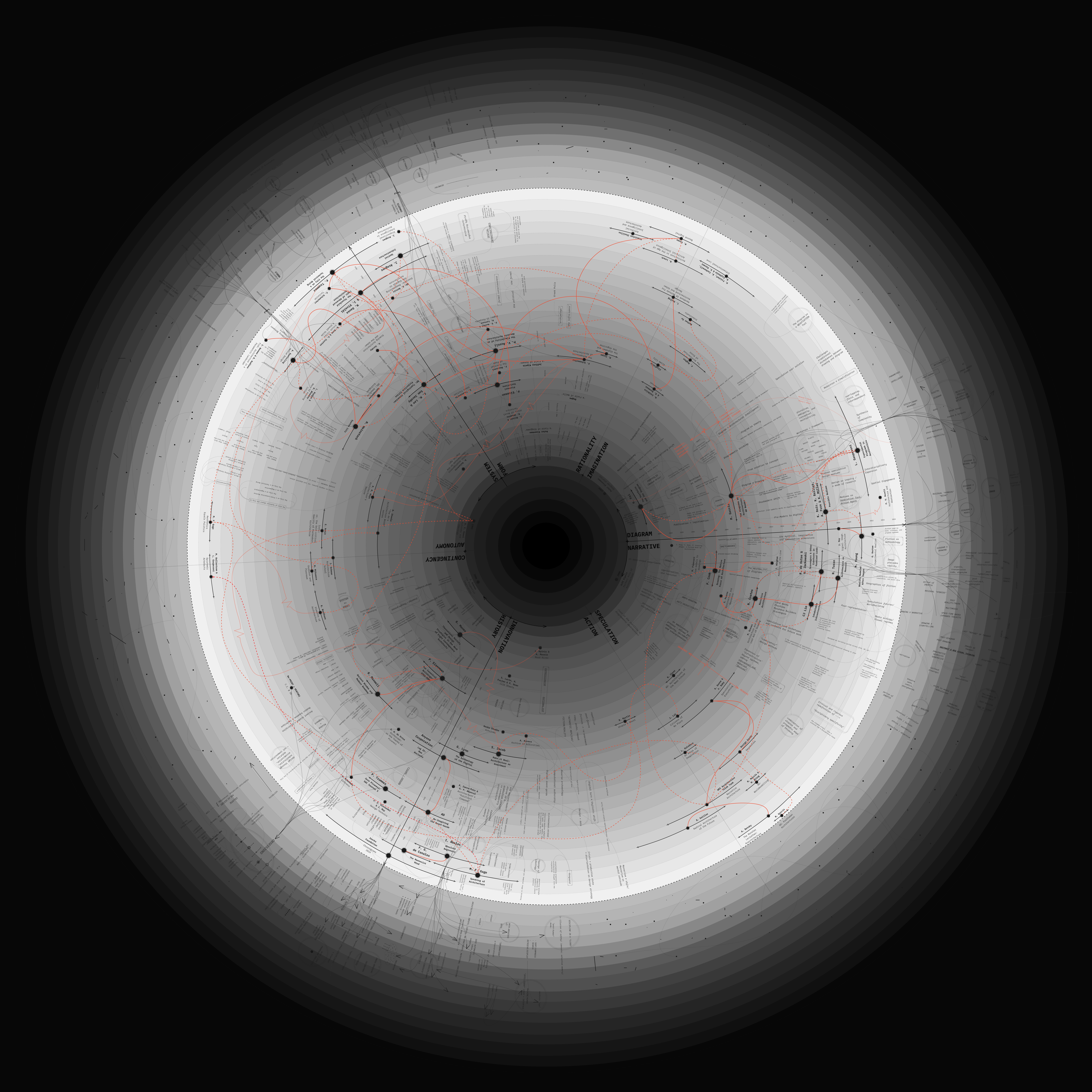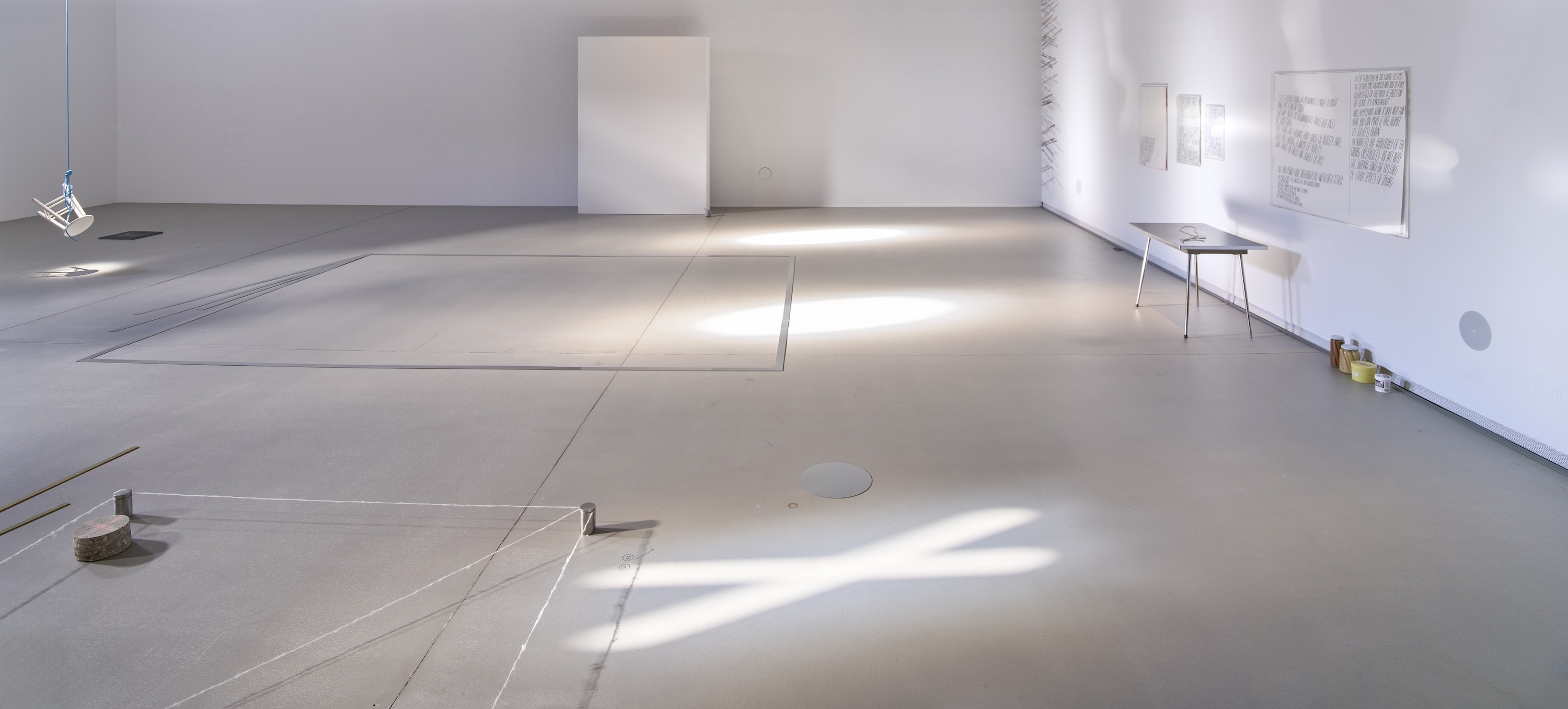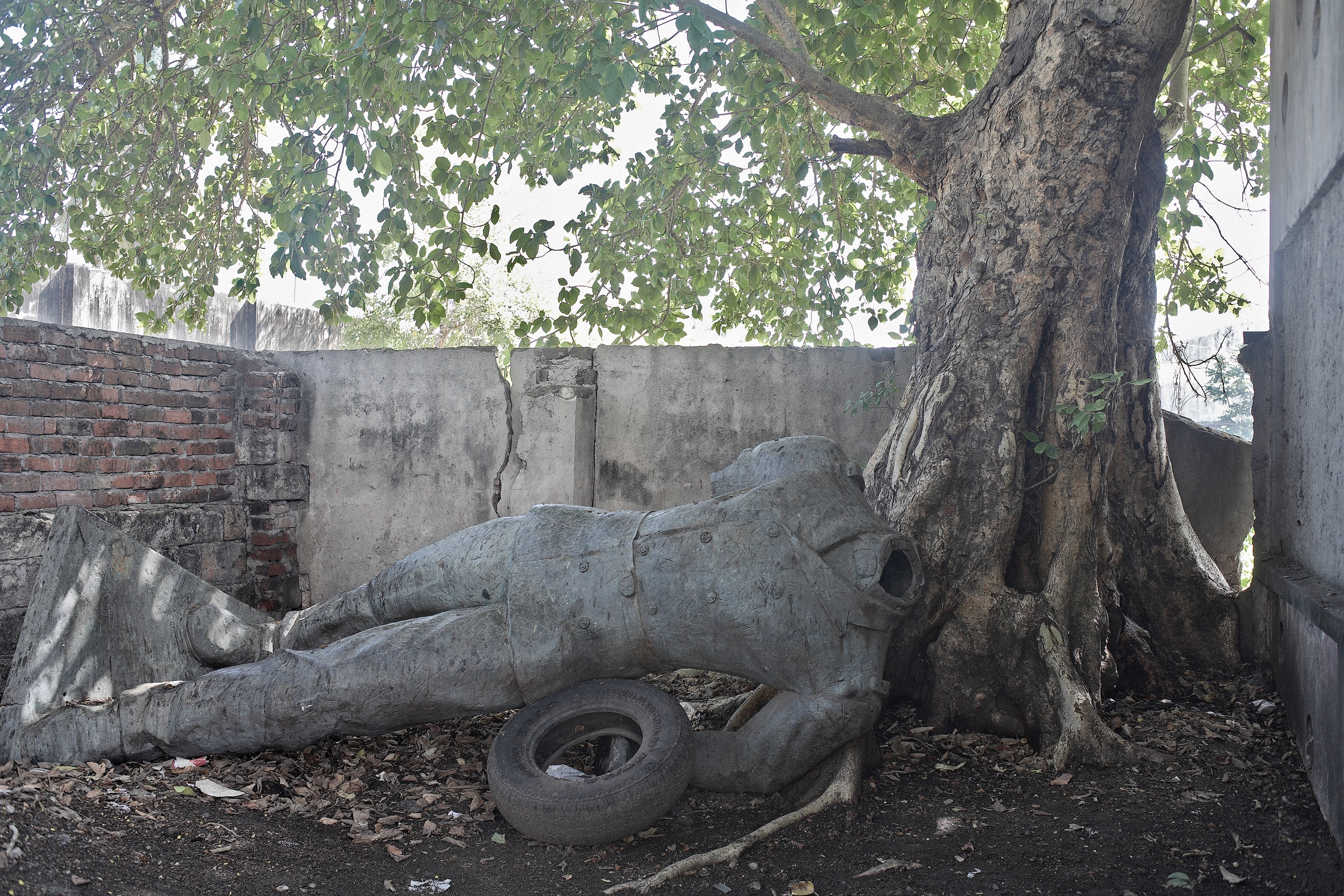This is the second installment in a two-part essay exploring the aesthetics and politics of the representation/abstraction dyad. For part one, which considered the history of New York’s Just Above Midtown gallery, among other spaces, curators, and artists who rejected received ideas about how abstraction and representation should operate, please click here.
Given the intense pressures facing many artists who identify and/or are marked as being in some sense “Other,” it isn’t hard to understand why the radical aesthetic and political world of spaces like Just Above Midtown might seem so compelling and so contemporary, despite nearly fifty years of historical distance. Figures like Linda Goode Bryant, Senga Nengudi, David Hammons, Howardena Pindell, and Randy Williams confronted something approaching a double bind, in which loyalty to an emergent Black nation seemingly meant sacrificing artistic complexity, and yet managed to repurpose this contradiction as a source of creative, critical dynamism. Over and against the long-facile valorization of abstraction or more recent dogmas surrounding representation, such artists instead grounded their practices in the rejection of false oppositions and in attempts to trace the imbrication of aesthetics and politics in the hybrid, conceptual-material forms that Bryant memorably framed as contextures.
That said, any effort to reckon with the more recent implications of such precedents quickly encounters a fundamental problem. Not only is it necessary to think abstraction and representation in terms of their interdependence, even their constitutive entanglement; we also have to radically historicize them, forming constellations with determinate aspects of our own present conjuncture. Such a task is complex, to say the least. The problem is not just that half a century of art history separates us from the moment of JAM’s inception, within which countless aesthetic mutations have occurred, some of which extend to the most basic means by which we identify specific objects or phenomena as art. It also derives from the fact that the sociopolitical meanings of abstraction and representation (both inside and outside art) have undergone transformations that are just as numerous and profound, if not more so.
In terms of the cultural politics of representation, we can gain some sense of this shift by reconsidering the 1993 Whitney Biennial, which has gone down in popular memory as “the identity politics biennial” and is emblematized by bluntly confrontational works like Daniel Joseph Martinez’s I CAN’T IMAGINE EVER WANTING TO BE WHITE buttons. At the time, Jed Perl read the show as a manipulative ploy to force “white male critics into a sweat of guilt and remorse and accommodation,” a quasi-paranoid grievance whose tone echoed similar claims made by the likes of Peter Schjeldahl, Robert Hughes, and Michael Kimmelman.1 If such responses reek of white fragility, they also reflect a perception, not inaccurate, that the hegemony of a racialized liberal modernist orthodoxy was being challenged in the very institutions that had long enforced it. Retrospectively, when mainstream critics objected, as nearly all did, that there wasn’t enough “beauty” or painting in the show, what they really seemed to be expressing was the anxious awareness that their claims to universal judgments were in fact highly particular, not to mention deeply suspect.
Digging further, one way to retrospectively understand the explosive, influential sensibility of the 1993 Biennial is as a fusion of two specific modes of representation: the first political (the forms of radical self-determination and solidarity that structured the emancipatory movements of the post-Sixties era and the new coalitions necessitated by the AIDS crisis and the Reagan-era culture wars), and the second artistic (a range of figurative, conceptual, and agitprop postmodernist practices including various forms of appropriation, montage, media art, and installation). If the show remains notorious, that’s not just on account of its scandal, but also because its pivot toward a hybridized, aesthetico-political representation proved to be prescient. During the next decade or so, progressive institutions in the nascent field of contemporary art shifted their agendas toward the new orientation heralded by the biennial, defining a new left-liberal consensus around terms like multiculturalism, inclusion, and diversity. As they did so, they gradually institutionalized formats that had initially been conceived of as non-aesthetic or anti-aesthetic, such as video, body art, performance, and the participatory modes that would soon be called social practice.
This fundamental shift has inalterably shaped the horizon of both mainstream and experimental cultural production, following a trajectory whose coordinates remain only partially understood. Some basic facts are inarguable: at this point, hardly anyone short of a Hilton Kramer would argue for the primacy of modernist forms or against a politics of difference; even some of the harshest critics of the 1993 Biennial have walked back their initial responses. In the aftermath of the so-called “Great Awokening” that followed the 2016 US presidential election, during which cultural institutions across the board have scrambled to diversify their programming and staffing, the practices of museums and galleries have finally begun to more closely approximate the aesthetic and political demands made in the collective rights struggles of the 1960s and in autonomous spaces like JAM.
That said, the history of the past three decades starkly contradicts any simplistic liberal narrative of progressive emancipation by means of greater representation in the cultural sphere. Consider the phenomenon of biennialization: as critics long ago pointed out, the proliferation of exhibitions foregrounding underrepresented artists outside the global North has all too often been an instrument of hegemony, through which anti-democratic states have laundered their reputations via nation-branding while neoliberal institutions (including art markets and academia) have extended their reach through overt and covert means.2 For artists, participation in such venues represents a kind of poisoned chalice in that the path to “success” can require them to acquiesce to, or even actively reproduce, the very conditions that prevent them from assuming an effectively critical position.
This problem is often acutely experienced around the unspoken norms and conventions that regulate the production of an artist’s identity, whether within the work itself or in its discursive frame. In the 1980s and ’90s, during the first round of the culture wars, artists marked as “Other” were typically tokenized, singled out as the privileged representative of their class and expected to act as a kind of model minority, translating collective experience into dominant forms in ways that would enrich (and wouldn’t threaten) affluent white liberal audiences. In the ensuing decades, particularly post-Obama, difference has in many ways become the lingua franca of contemporary art, to the point where biennials can now be majority-minority without attracting much notice, even in the US. (The extent to which this is more true of ethnicity than gender, class, or disability remains up for debate.)
In no way does this mean that normative difference has disappeared; artists can still feel a keen pressure to self-tokenize. Rather, the issue is that “difference” has become in a sense undead: on the one hand, lifeless and homogenized; on the other, an active site of seemingly automated value-production. Underlying this problem is the fact that culture has increasingly become determined by forces that radically constrain the freedoms that art routinely aspires to (or naively assumes it possesses): the pervasive subsumption of sensate and psychic life through digital technologies; the neutralization of emancipatory politics through mechanisms of “elite capture” or identity policing; the increased flexibilization and precaritization of labor in polycrisis-era capitalism; and the self-reinforcing character of neoliberalism under conditions of real abstraction.3
All too often these are the sort of issues that artists or curators might grapple with privately, making them the contemporary equivalent of what T.J. Clark once termed “the bad dream of modernism.”4 So it was both surprising and welcome to find an exhibition devoted to exploring precisely this phenomenon: “Searching the Sky for Rain,” a fiercely intelligent group show curated by Sohrab Mohebbi at New York’s SculptureCenter in 2019. The exhibition included sixteen artists, most of them early- to mid-career and LGBTQ+ and/or BIPOC-identifying. No one particular approach was favored; works were made from materials including faux marble, stained glass, styrene, and surveillance mirrors, and produced using techniques ranging from earthenware glazing and woodworking to audio recording and video installation. An uninformed visitor to the show might easily have assumed that its indifference to questions of medium derived from the more general eclecticism that has long been said to characterize contemporary art.
Such a view was quickly dispelled by Mohebbi’s catalog essay, which integrated the works on display into a far-reaching argument about the structural conditions of possibility supporting the production, circulation, and exhibition of art made by artists marked as Other. Mohebbi’s thesis, trenchantly summarized in a polemical aside against the “fracking of particularities,” was that within neoliberalism artistic commodification operates as a kind of immaterial extractivism that targets subjectivity, linking the perceived value of an artwork to the specific modes of identity and/or difference mobilized by its content and its producer’s biography.5 On this view, art struggles to do more than represent a kind of abstract difference that makes no concrete difference to actual power relations; the most it can do is produce an empty novelty that serves only to generate exchange value, most of which accrues to private institutions or individual collectors.
This line of critique draws convincing connections between the mundane decisions faced by working artists and curators––for example, whether or how to include biographical information in an artist’s statement, wall text, or catalog essay––and the much more diffuse logics that govern the cultural sphere. As Mohebbi astutely observes, LGBTQ+ and/or BIPOC artists are now routinely expected to brand or perform their difference in a way that weirdly recalls the mechanics of niche marketing, or the sort of DIY entrepreneurialism of YouTube influencers and content creators. This mode of production, which has basically become ubiquitous in only the last decade or so, is typically complicit with forces of social or political normativity insofar as artists are incentivized to align their practices with prefabricated, hegemonic categories of recognizability. For example, Black artists today don’t face anything like the sort of exclusionary pressures that Hammons or Nengudi did, but it’s abundantly clear that the quickest route to institutional success is to make work about Blackness, ideally in a mode that won’t prove too unsettling to collectors or to the interests of majority-white institutions.
The liberal counterargument would most likely be to claim that it will take time and patience to undo age-old injustices. While these claims might have some merit, they miss the fact that the inclusion of historically marginalized artists typically takes place in circumstances that reproduce inequality or even exploitation. Not only does such inclusion often require a kind of racialized (or gendered or classed) self-promotion; it is also transparently a form of individuation, one that increases competition for still-scarce resources while also foreclosing the forms of solidarity that might emerge within or between groups. Furthermore, it clearly fails in the pivotal and much more difficult task of identifying, analyzing, and contesting the means of exclusion on which museums and collections are built and maintained. This was among the most radical, generative questions posed by Strike MoMA in 2021: If museums like MoMA can’t definitively be extricated from economies of mass dispossession and death, why should we want them at all?
Pivoting away from this macro-level account, Mohebbi proceeded to ask how exactly art might be able to resist mechanisms of extraction through the singular agencies of the aesthetic. His core move was to reframe two familiar keywords by embedding them within a pair of rhetorical questions: Who owns the right to abstraction? and Who owns the project of critique? The intent was clear: in a moment when visibility and legibility are all too easily monetized, the values historically associated with non-representational art (e.g. ambiguity, opacity, uselessness) could assume new relevance; while the potential of critical practice can only be unlocked once it acknowledges and transcends its own social exclusivity. (It was less clear why Mohebbi chose to use the rhetoric of rights and property, given their close connection to the bourgeois ideology of possessive individualism; or how he might have understood linkages between the histories of coloniality, aesthetic discourse, and critical philosophy.)
A second, more promising line of thought concerned the ways in which art and the aesthetic might function within a larger collective project of de- and re-subjectivation. Here, Mohebbi’s reference points were not drawn from recent decolonial theorists like Walter Mignolo but rather from its antecedents, including Third World Feminism (Gloria Anzaldúa), Subaltern Studies (Partha Chatterjee), and diasporic theory (Paul Gilroy). What remains relevant in these debates, Mohebbi argued, is their view that minoritarian subjectivities are inherently kinetic, relational, and self-differentiating; that they contain generative contradictions; and that these properties enable them to resist the sort of capture on which value-extraction depends.
On this view, the strategic value of minoritarian aesthetic practice doesn’t derive from widening the existing playing field, but from initiating a transversal, de-individuating movement toward emancipation or productive negation. This capacity to dissolve empty or exploitative identities enables a process of desubjugation; citing Fred Moten, Mohebbi explains that this means “not desiring what was not to be desired in the first place.” In addition, experimental art’s intrinsic affinity for recombination makes it well-suited to produce new political coalitions in a moment when the need for more effective solidarities and antagonisms is obvious. As Mohebbi implies, such practices can effect complex mediations between abstraction and representation, advocating for the interests of transversal minoritarian alliances (ones that sometimes have to include privileged white liberals) while using abstract modalities to produce new categories of recognition, relation, and action.
Curating is of course its own form of mediation, and the ambitious task that Mohebbi set was to practically implement this argument in ways that could persuasively demonstrate its aesthetic and political efficacy. One key gambit in “Searching the Sky for Rain” was to historicize the approaches it surveyed through the inclusion of Charles Gaines and Tony Cokes, two Black artists with decades of experience reworking the boundaries between abstraction and representation, each of whom has moreover influenced numerous cohorts of younger artists through their dedication to teaching (at CalArts and Brown respectively). The most relevant aspect of Gaines’s oeuvre was his protracted elaboration of a practice in which abstract systems of value, including numbers and colors, are used to generate pictorial representations. Cokes’s contribution was clearer: a consistent commitment to the analysis of race, class, and power through methods of ideology critique.
Their contributions were set alongside strong work by early-career artists like Rindon Johnson, who has developed a polymathic practice combining technical media and poetry with forms of artistic research that intersect their subject position as a Black trans American. Johnson’s sculptures were mainly executed in aged animal hide, a medium grounded in the necessities of bare life and evoking conditions of exposure to a primordial privation or violence. In the context of Mohebbi’s argument, these skins––which ranged in color from lightly tanned and almost translucent to a patchily charred black––recalled Frantz Fanon’s concept of epidermalization: the idea that racial hierarchies are mapped onto the surface of the body at an originary level. If Johnson’s sculptures, hovering in the cavernous spaces of the main gallery like apparitions, brilliantly allegorized the ways that this constitutive racism continues to haunt the institution of art, they simultaneously enacted the core ambivalence that those stigmatized by difference can feel toward its sensible manifestations.
Skin also played a role within the aesthetics of ektor garcia, who contributed a suite of deceptively modest ceramic works, one of which explicitly took the term “hides” as its subject and title. This reflected a long-term interest of the artist, some of whose earlier works have explored the significance of animal hide in the informal economies of modern Mexico and the cosmology of pre-Columbian societies. Much of this production has been executed through processes like crochet and in mediums like lace and leather, coded as artistically inferior on account of their alleged status as feminine, craft-based, and non-conceptual; by strategically disabling such hierarchizations, garcia has deftly combined his research into craft traditions and contemporary racializations of labor with a distinctively queer erotics and ethics of bodily vulnerability.
In work like this, representation and abstraction are entangled in ways that sidestep received ideas about authenticity or cultural difference; it’s largely irrelevant, for instance, that garcia’s parents worked as migrant laborers in California. What does matter is the singular way in which garcia’s abstractions manage to simultaneously withhold certain meanings while transmuting, condensing, or reanimating others. This suggests a subtle but decisive displacement of Édouard Glissant’s conception of opacity, which has become nearly ubiquitous in progressive contemporary art discourse. Instead of an opaque, solid mask, whose function is primarily defensive, works like garcia’s act more like translucent mesh screens, allowing certain meanings to be communicated while enshrouding others in layers of ambiguity or secrecy.
Such situations make it unmistakably clear that art’s intrinsically evanescent and plural mediating function is incompatible with the demands of identity politics, at least the reified, essentially neoliberal versions of the latter that have been mainstreamed in recent years. Art––at least in the critically and aesthetically sophisticated versions that Mohebbi skillfully selected––is constitutively incapable of speaking in a singular voice; its grammar is always some combination of indicative and subjunctive, and is thus in contradiction with the instrumentality we expect of political action. While this idea might not itself be completely novel, the innovative character of “Searching the Sky for Rain” lay in its ability to conjugate such quasi-dialectical insights with a keen grasp of the ways artists have been developing their practices in response to the rapidly shifting terrain of the new culture wars, in which a trend and its backlash seem to occur simultaneously. At SculptureCenter, it became possible to sense new relevance in the intentionally ambiguous approach taken by artists working to rearticulate the categories of abstract and representational art such that new forms of de- and re-subjectivation might become possible.
In a neo-reactionary moment when ostensibly progressive politics has increasingly become a site of normativity and extraction, art is in a unique position to experiment with the aesthetic substrates that enable political action, adopting the hybrid strategies that Linda Goode Bryant so usefully theorized as “contextures.” What might look to some like passivity or reticence can in fact be a kind of strategic detour, both in the sense of turning away (from overly legible, weakly “political” art) and of exploring alternative routes. If art wants to move forward––however we might want to define that––it would do well to follow this model and to move like a crab: keeping low, moving sideways through the liminal spaces between land and water, attacking by surprise before scuttling back into temporary obscurity.
I would like to thank Stanley Wolukau-Wanambwa and J. Myers-Szupinska for their valuable assistance.
See Jerry Saltz and Rachel Corbett, “How Identity Politics Conquered the Art World: An oral history,” New York, (April 18, 2016), https://www.vulture.com/2016/04/identity-politics-that-forever-changed-art.html.
Many of these early critical accounts can be found in The Biennial Reader, eds. Elena Filipovic, Marieke Van Hal, Solveig Øvstebø (Bergen: Bergen Kunsthall; Berlin: Hatje Cantz, 2010).
See among others: Keeanga-Yamahtta Taylor, From #BlackLivesMatter to Black Liberation (Chicago: Haymarket, 2016); Asad Haider, Mistaken Identity: Race and Class in the Age of Trump (New York: Verso, 2018); Olúfémi O. Táíwò, Elite Capture: How the Powerful Took Over Identity Politics (And Everything Else) (Chicago: Haymarket, 2022); In the Mind But Not From There: Real Abstraction and Contemporary Art, ed. Gean Moreno (New York: Verso, 2019).
The reference is to Clark’s reading of Cecil Beaton’s 1951 photographs of Vogue models posing before Jackson Pollock abstractions in Chapter 7 of Farewell to an Idea (New Haven: Yale University Press, 1999), 61.
The show’s catalog is available for download/purchase via this link. Subsequent references are to Mohebbi’s catalog essay.
